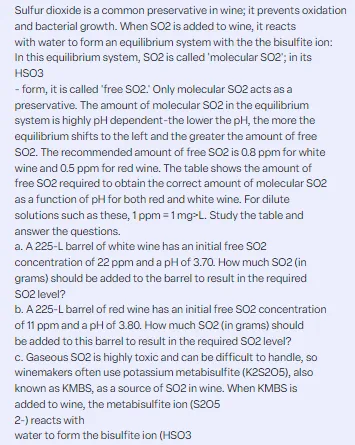Question
Sulfur dioxide is a common preservative in wine; it prevents oxidation
and bacterial growth. When SO2 is added to wine, it reacts
with water to form an equilibrium system with the the bisulfite ion:
In this equilibrium system, SO2 is called ‘molecular SO2’; in its
HSO3
– form, it is called ‘free SO2.’ Only molecular SO2 acts as a
preservative. The amount of molecular SO2 in the equilibrium
system is highly pH dependent-the lower the pH, the more the
equilibrium shifts to the left and the greater the amount of free
SO2. The recommended amount of free SO2 is 0.8 ppm for white
wine and 0.5 ppm for red wine. The table shows the amount of
free SO2 required to obtain the correct amount of molecular SO2
as a function of pH for both red and white wine. For dilute
solutions such as these, 1 ppm = 1 mg>L. Study the table and
answer the questions.
a. A 225-L barrel of white wine has an initial free SO2
concentration of 22 ppm and a pH of 3.70. How much SO2 (in
grams) should be added to the barrel to result in the required
SO2 level?
b. A 225-L barrel of red wine has an initial free SO2 concentration
of 11 ppm and a pH of 3.80. How much SO2 (in grams) should
be added to this barrel to result in the required SO2 level?
c. Gaseous SO2 is highly toxic and can be difficult to handle, so
winemakers often use potassium metabisulfite (K2S2O5), also
known as KMBS, as a source of SO2 in wine. When KMBS is
added to wine, the metabisulfite ion (S2O5
2-) reacts with
water to form the bisulfite ion (HSO3
-). Write the balanced
equation for the reaction that occurs when the metabisulfite
ion reacts with water.
d. Determine the percent by mass of SO2 in KMBS.
e. How much KMBS must a winemaker add to the barrels of
wine in problems (a) and (b) to achieve the required amount
of molecular SO2?
Answer
Table of Contents
Using Sulfur Dioxide as a Wine Preservative: Dosage and pH Considerations
Sulfur dioxide (SO₂) is widely used in the winemaking industry as a preservative to prevent oxidation and bacterial growth. Its effectiveness as a preservative is highly dependent on the concentration of molecular SO₂, which is influenced by the pH of the wine. This article delves into the role of sulfur dioxide in wine preservation, the importance of pH in determining the required SO₂ levels, and the calculations necessary to achieve optimal preservation.
The Role of Sulfur Dioxide in Wine Preservation
Sulfur dioxide acts as an antioxidant and antimicrobial agent in wine. It protects wine from oxidation, which can lead to undesirable changes in flavor, color, and aroma. Additionally, SO₂ inhibits the growth of bacteria and wild yeast, ensuring the wine remains stable during storage and aging. In the equilibrium system of wine, SO₂ exists in two forms: molecular SO₂ and bisulfite ion (HSO₃⁻). Only the molecular form provides the preservative effects desired by winemakers.
The Importance of pH in SO₂ Effectiveness
The pH of wine significantly affects the equilibrium between molecular SO₂ and bisulfite ion. Lower pH levels favor the presence of molecular SO₂, enhancing its preservative action. Conversely, higher pH levels reduce the concentration of molecular SO₂, diminishing its effectiveness. Therefore, winemakers must carefully monitor and adjust the pH of the wine to maintain the desired levels of free SO₂.
Recommended SO₂ Levels
For optimal preservation, the recommended amount of free SO₂ varies between different types of wine. White wines typically require 0.8 ppm of free SO₂, while red wines require 0.5 ppm. These values ensure that enough molecular SO₂ is present to protect the wine without negatively affecting its taste and aroma.
Calculating the Required SO₂ Additions
Let’s explore how to calculate the amount of SO₂ needed to adjust the free SO₂ levels in wine based on its initial concentration and pH.
Example Calculations
White Wine Adjustment
Consider a 225-liter barrel of white wine with an initial free SO₂ concentration of 22 ppm and a pH of 3.70. To achieve the recommended 0.8 ppm of molecular SO₂, we need to determine the additional amount of SO₂ required.
- Calculate the required free SO₂ level: Given the pH of 3.70, use the appropriate table or formula to find the required free SO₂ level for the desired molecular SO₂ concentration.
- Determine the additional SO₂ needed: Subtract the initial free SO₂ concentration from the required free SO₂ level.
- Convert to grams: Multiply the additional SO₂ concentration by the volume of wine to find the amount in grams.
Red Wine Adjustment
Now, consider a 225-liter barrel of red wine with an initial free SO₂ concentration of 11 ppm and a pH of 3.80. Follow similar steps to calculate the required SO₂ addition for this scenario.
Using Potassium Metabisulfite (KMBS) as an SO₂ Source
Due to its toxicity and handling difficulties, gaseous SO₂ is often replaced with potassium metabisulfite (KMBS) in winemaking. KMBS releases bisulfite ions (HSO₃⁻) when dissolved in water, which then form SO₂.
Reaction and Calculation
The reaction for KMBS in water is:
K2S2O5+H2O→2KHSO3
To determine the required KMBS for the calculated SO₂ additions:
- Calculate the molar mass of KMBS: Use the periodic table to find the molar masses of the elements in KMBS and sum them.
- Find the mass percent of SO₂ in KMBS: Calculate the proportion of SO₂ in the molar mass of KMBS.
- Determine the amount of KMBS needed: Based on the mass percent, calculate the required mass of KMBS to achieve the necessary SO₂ levels in the wine.
Conclusion
Sulfur dioxide is a crucial preservative in winemaking, essential for maintaining wine quality during storage and aging. Understanding the relationship between pH and SO₂ effectiveness allows winemakers to make precise adjustments to achieve optimal preservation. By following the outlined calculations and utilizing potassium metabisulfite as an SO₂ source, winemakers can ensure their wines remain protected against oxidation and microbial spoilage.




